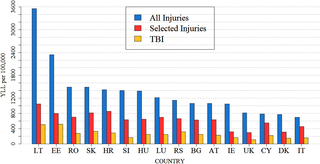PLOS Medicine ( IF 10.5 ) Pub Date : 2017-07-11 , DOI: 10.1371/journal.pmed.1002331 Marek Majdan , Dominika Plancikova , Andrew Maas , Suzanne Polinder , Valery Feigin , Alice Theadom , Martin Rusnak , Alexandra Brazinova , Juanita Haagsma

|
Introduction
Traumatic brain injuries (TBIs) are a major public health, medical, and societal challenge globally. They present a substantial burden to victims, their families, and the society as a whole. Although indicators such as incidence or death rates provide insight into the occurrence and outcome of TBIs in various populations, they fail to quantify the full extent of their public health and societal impact. Measures such as years of life lost (YLLs), which quantifies the number of years of life lost because the person dies prematurely due to a disease or injury, should be employed to better quantify the population impact. The aim of this study was to provide an in-depth analysis of the burden of deaths due to TBI by calculating TBI-specific YLLs in 16 European countries, analyzing their main causes and demographic patterns, using data extracted from death certificates under unified guidelines and collected in a standardized manner.
Methods and findings
A population-wide, cross-sectional epidemiological study was conducted in 16 European countries to estimate TBI YLLs for the year 2013. The data used for all analyses in this study were acquired from the statistical office of the European Union (Eurostat). A specifically tailored dataset of micro-level data was provided that listed the external cause of death (International Classification of Diseases–10th Revision [ICD-10] codes V01–Y98), the specific nature of injury (ICD-10 codes S00–T98), the age at death, and sex for each death. Overall number of TBI YLLs, crude and age-standardized TBI YLL rates, and TBI YLLs per case were calculated stratified for country, sex, and age. Pooled analyses were performed in order to estimate summary age-standardized rates of TBI YLLs. In order to evaluate the relative importance of TBI in the context of all injuries, proportions of TBI YLLs out of overall injury YLLs were calculated. The total number of TBI YLLs was estimated by extrapolating the pooled crude rate of TBI YLLs in the 16 analyzed countries to the total population of the 28 member states of the EU (EU-28). We found that a total of 17,049 TBI deaths occurred in 2013 in the 16 analyzed countries. These translated into a total of 374,636 YLLs. The pooled age-standardized rate of YLLs per 100,000 people per year was 259.1 (95% CI: 205.8 to 312.3) overall, 427.5 (95% CI: 290.0 to 564.9) in males, and 105.4 (95% CI: 89.1 to 121.6) in females. Males contributed substantially more to TBI YLLs than females (282,870 YLLs, 76% of all TBI YLLs), which translated into a rate ratio of 3.24 (95% CI: 3.22 to 3.27). Each TBI death was on average associated with 24.3 (95% CI: 22.0 to 26.6) YLLs overall, 25.6 (95% CI: 23.4 to 27.8) in males and 20.9 (17.9 to 24.0) in females. Falls and traffic crashes were the most common external causes of TBI YLLs. TBI contributed on average 41% (44% in males and 34% in females) to overall injury YLLs. Extrapolating our findings, about 1.3 million YLLs were attributable to TBI in the EU-28 in 2013 overall, 1.1 million in males and 271,000 in females. This study is based on administratively collected data from 16 countries, and despite the efforts to harmonize them to the greatest possible extent, there may be differences in coding practices or reporting between countries. If present, these would be inherited into our findings without our ability to control for them. The extrapolation of the pooled rates from the 16 countries to the EU-28 should be interpreted with caution.
Conclusions
Our study showed that TBI-related deaths and YLLs have a substantial impact at the individual and population level in Europe and present an important societal and economic burden that must not be overlooked. We provide information valuable for policy-makers, enabling them to evaluate and plan preventive activities and resource allocation, and to formulate and implement strategic decisions. In addition, our results can serve as a basis for analyzing the overall burden of TBI in the population.
中文翻译:

欧洲因脑外伤而丧生的年:对16个国家的横断面分析
介绍
颅脑外伤(TBI)是全球范围内的主要公共卫生,医学和社会挑战。它们给受害者,他们的家人以及整个社会带来沉重的负担。尽管诸如发生率或死亡率之类的指标可以洞悉各种人群中TBI的发生和结果,但它们无法量化其公共卫生和社会影响的全部范围。应该采用诸如丧命年数(YLLs)之类的方法来量化因人因疾病或伤害过早死亡而丧命的年数,以便更好地量化对人口的影响。这项研究的目的是通过计算16个欧洲国家/地区特定于TBI的YLL,分析其主要原因和人口统计学特征,从而对TBI造成的死亡负担进行深入分析。
方法和发现
在16个欧洲国家/地区进行了一项针对整个人群的横断面流行病学研究,以估算2013年的TBI YLL。本研究中用于所有分析的数据均来自欧盟统计局(Eurostat)。提供了专门定制的微观水平数据集,其中列出了外部死亡原因(国际疾病分类–第十次修订版[ICD-10]代码V01–Y98),伤害的特殊性质(ICD-10代码S00–T98) ),死亡年龄以及每次死亡的性别。根据国家,性别和年龄,对每个案例的TBI YLL总数,原始和年龄标准化的TBI YLL比率以及TBI YLL进行了分层计算。进行汇总分析,以估算TBI YLL的年龄标准化总结率。为了评估TBI在所有伤害情况下的相对重要性,计算了TBI YLL在总伤害YLL中的比例。TBI YLL的总数是通过将16个分析国家/地区中TBI YLL的合并原始汇率外推到欧盟28个成员国(EU-28)的总人口中得出的。我们发现,在16个分析的国家/地区,2013年共有17049例TBI死亡。这些总计转化为374,636个YLL。汇总的每10万人每年的YLL年龄标准化率总体为259.1(95%CI:205.8至312.3),男性为427.5(95%CI:290.0至564.9),男性为105.4(95%CI:89.1至121.6)在女性中。男性对TBI YLL的贡献要远远大于女性(282,870 YLL,占所有TBI YLL的贡献),转化率为3.24(95%CI:3.22至3.27)。每次TBI死亡平均与总的24.3(95%CI:22.0至26.6)YLL,男性25.6(95%CI:23.4至27.8)和女性20.9(17.9至24.0)有关。跌落和交通事故是TBI YLL的最常见外部原因。TBI对总体伤害YLL的贡献平均为41%(男性为44%,女性为34%)。根据我们的发现,2013年欧盟28国的TBI总计约有130万名YLL,男性为110万名,女性为271,000名。这项研究基于从16个国家/地区收集来的行政管理数据,尽管尽最大努力使这些数据保持一致,但各国之间在编码实践或报告方面可能会有所不同。如果存在,这些将被继承到我们的发现中,而我们无法控制它们。
结论
我们的研究表明,与TBI相关的死亡和YLL对欧洲的个人和人口产生了重大影响,并带来了不容忽视的重要社会和经济负担。我们为决策者提供有价值的信息,使他们能够评估和计划预防活动和资源分配,以及制定和实施战略决策。此外,我们的结果可作为分析人口中TBI总体负担的基础。











































 京公网安备 11010802027423号
京公网安备 11010802027423号